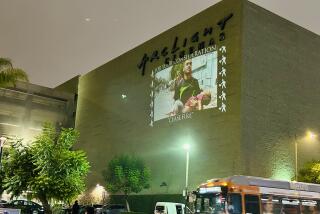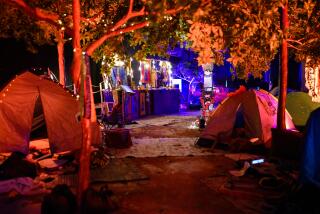ART : Pleas for Peace : Works by an Israeli institute’s Arab and Jewish children emphasize the need for trust and understanding.
- Share via
For many people, the Mideast peace talks that began last year are the first sign of hope for peace between Arabs and Jews. However, well before those talks began, there was the Givat Haviva Institute in Israel.
In 1949, the year after the state of Israel was founded, this educational organization was established by a federation of kibbutzim to build understanding and trust between Arab and Jewish communities within Israel.
One of Givat Haviva’s current programs is “Children’s Art for Peace,” which brings students between 12 and 14 from both communities to paint and draw side by side at the institute’s art center. More than 300 works by last year’s students have been divided among five exhibitions, which are traveling throughout North America in 1992 and 1993.
The tour began in March at the House of Representatives Office Building in Washington. Now an exhibit of 75 paintings and drawings is on display at the University of Judaism’s Platt Gallery. A touching video called “A Place for Understanding” accompanies the exhibit.
The Givat Haviva Institute’s 50-acre campus serves 40,000 people each year. Besides the institute and some smaller organizations devoted to Arab-Jewish relations, there is little contact between Arabs and Jews who for generations have lived within Israel’s pre-1967 borders as taxpayers and voting citizens. In fact, one out of every six Israeli citizens there is Arab.
“There is an ignorance of the existence of the Arab community in Israel on the part of everybody, including the Jewish community here,” said Steven Goldberg, executive director of the Givat Haviva Educational Foundation in New York City, and referring to U.S. Jews in general.
He termed the Arabs loyal citizens. “They see themselves as Israelis. It is important to us to bring the whole subject area of Jewish-Arab relations to the forefront . . . to build bridges instead of walls.”
Givat Haviva, which means “Haviva’s Hill,” was named after Haviva Reik, a kibbutz member who volunteered to serve in the Resistance in Europe during World War II and was executed by the Nazis in 1944.
Besides its youth programs, the institute, located about halfway between Tel Aviv and Haifa, provides seminars on such topics as Middle East history, peace research and conflict resolution, and the Hebrew and Arabic languages. It operates Israel’s largest research center devoted to the history and current state of the Israeli Arab community.
Jack Flier, chairman of the Platt Gallery’s fine arts council, who has been involved with Givat Haviva since his first trip to Israel in 1966, encouraged the university to sponsor the exhibit.
“I loved the concept--especially after the riots here--that people can get to know each other,” he said.
“We can see how the young Arab and Jewish students talked about peace and understanding. Here’s what they did under very difficult circumstances.”
Flier refers to the Persian Gulf War interrupting the students’ project.
Doves, the universal symbol of peace, are prominent images in the pictures of both Arab and Jewish children.
An Arab girl’s drawing of a dove behind barbed wire aptly symbolizes the tension in the program participants’ lives. However, direct depictions of violence are nowhere to be seen.
Many Arab children painted colorful compositions featuring flowers. One Jewish child’s drawing of several torsos and figures includes one on a cross.
Posted among the artwork are students’ comments. Hagai Shabtai, a 13-year-old Jewish Israeli, said: “I don’t actually know how I feel about working with Arab students ‘cause no one has really tried to communicate. I was a bit afraid. I’m less afraid now. I’m starting to see nobody is as bad as they seem.”
Ibrahim Abu Helal, a 14-year-old Arab Israeli, said: “The program is good. It is the first opportunity I have had to paint. I don’t find it difficult to work next to Jewish Israelis--I feel good about it.”
Where and When Exhibit: “Children’s Art for Peace.” Location: University of Judaism’s Platt Gallery, 15600 Mulholland Drive, Los Angeles. Hours: 10 a.m. to 4 p.m. Mondays through Thursdays, 10 a.m. to 2 p.m. Fridays, through Dec. 6. Call: (310) 476-9777, Ext. 276.
More to Read
The biggest entertainment stories
Get our big stories about Hollywood, film, television, music, arts, culture and more right in your inbox as soon as they publish.
You may occasionally receive promotional content from the Los Angeles Times.










